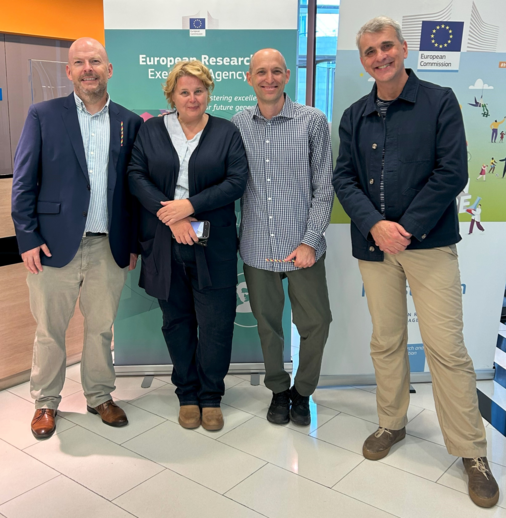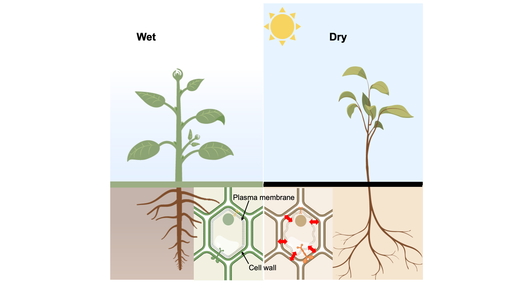How Do Plants Sense Water?
Prestigious ERC Synergy Grant for elucidating a universal mechanism for water sensing in plants: Scientists from Regensburg, Nottingham, Tel Aviv, and Trondheim investigate how plants can measure water stress and minimize water loss during drought periods.
26 October 2023
The European Research Council (ERC) has awarded one of its most prestigious research awards, an ERC Synergy Grant, to Professor Dr. Christine Ziegler, biophysicist at the University of Regensburg, and biologists Professor Dr. Malcolm Bennet (University of Nottingham, Professor Dr. Eilon Shani (Tel Aviv University), and Professor Dr. Thorsten Hamann (Norwegian University of Science and Technology) for their research on plant water stress perception. The ERC is providing €10 million for their six-year HYDROSENSING project.
The European Research Council's special award can only be won as a team and supports established top researchers with scientifically groundbreaking projects that cannot be addressed by one research group alone. Proposals are evaluated on the sole criterion of scientific excellence which takes on the additional meaning of outstanding intrinsic synergetic effect.
University President Professor Dr. Udo Hebel congratulated on the ERC Synergy Grant: "The HYDROSENSING research project is not only unique in terms of content and methodology – it directly supports the global sustainability goals."

ERC Synergy Grant 2023 for HYDROSENSING and the research team (from left.) Prof. Dr. Thorsten Hamann, Prof. Dr. Christine Ziegler, Prof. Dr. Eilon Shani und Prof. Dr. Malcolm Bennet. Credit: Thorsten Hamann
Just like humans, plants need water to survive and thrive. The devastating effects of climate change are exacerbating water scarcity on Earth, with dramatic consequences for global agriculture and food security. To achieve necessary climate resilience in plants, it is crucial to understand how plants recognize quickly whether there is enough water available - to initiate countermeasures. The international HYDROSENSING team has made it their mission to answer this fundamental question. Understanding how plants perceive water stress is a prerequisite for the sustainable development of climate-resistant crops.
The interdisciplinary project wants to discover how plants perceive water stress on multiple scales - from organ to cellular to molecular level. Using a unique combination of innovative CRISPR technology and multiscale microscopy, biophysicist Ziegler together with her colleagues aims to identify key proteins involved in water stress sensing, generate high-resolution images of the processes occurring during water transport inside plants, and elucidate the regulatory interaction of water stress-detecting protein complexes at the molecular level. The scholars want to uncover fundamental mechanisms that explain how plants determine when water becomes "scarce".
Severe droughts in Europe
“Europe has experienced severe droughts in 2022 and 2023,” explains the British project partner Malcolm Bennet. “Despite the dramatic impacts on the environment, economy, and society, it remains unclear how plants perceive water stress. The scientific and technological expertise to unravel this lies beyond the boundaries of a single researcher and instead requires a partnership between groups.”
"To understand how plants perceive water stress, interdisciplinary collaboration and method development are essential," adds Christine Ziegler. "This requires intensive scientific partnership. We have already worked incredibly synergistically during the application process to develop our hypothesis that water stress is controlled through mechanical stimuli across the cell wall, affecting the transport of the water stress hormone Abscisic Acid (ABA)."
 HYDROSENSING in plants: Water stress stimuli are transduced into mechanical signals via cell wall -plasma membrane interactions. © Christine Ziegler, E. Shani et al.
HYDROSENSING in plants: Water stress stimuli are transduced into mechanical signals via cell wall -plasma membrane interactions. © Christine Ziegler, E. Shani et al.
Christine Ziegler, head of the Chair of Biophysics II and director of the new Regensburg Center for Ultrafast Nanoscopy (RUN), has a strong expertise on transport processes across the cell membrane regulated by external stress. She uses cryo-electron microscopy to determine atomic structures of membrane proteins in different transport states. "Plants are true survivors when it comes to stress adaptation, but due to their incredible genetic redundancy, it is challenging to formulate molecular mechanisms for plant proteins," explains Ziegler. "Only the groundbreaking work of Eilon Shani, who can simultaneously target entire gene families using CRISPR technologies, allows for a clear assignment of water stress proteins to plant phenotypes. The collaboration with my partners in the HYDROSENSING team presents a unique opportunity to examine molecular mechanisms in a cellular, even an organellar context."
Strengthening global food security
The multi-scale microscopy approach of the HYDROSENSING team includes aside of cryo-electron microscopy also confocal Brillouin microscopy, which allows for detailed investigation of mechanical stress signal propagation across the plant cell wall. The Norwegian partner Thorsten Hamann, whose work on the cell wall receptor kinase THESEUS 1 has significantly contributed to the idea of mechanical water stress signaling, brings this expertise to the team.
The innovative Stimulated Raman Scattering technology for imaging water movement in plants is being developed in the laboratory of Malcolm Bennet, whose recent investigations have shown that plant roots play a crucial role in reducing the effects of water stress. Malcolm Bennett explains: "We use state-of-the-art imaging techniques to track water movement inside plant cells. These are the first images of their kind ever created. These images allow us to observe the process of water transport in real-time."
The team coordinator, Eilon Shani, adds: "With our project, we aim to uncover universal design principles that explain the core mechanism for signaling water stress in plants. This new knowledge is crucial for international efforts to develop climate-resistant crops and strengthen global food security. This is only possible thanks to the synergy within the HYDROSENSING team."
Publications
Mehra P, et al. Hydraulic flux-responsive hormone redistribution determines root branching. (2022) Science. 378:762-768. doi:10.1126/science.add3771.
Hu Y, et al. Multi-Knock-a multi-targeted genome-scale CRISPR toolbox to overcome functional redundancy in plants. (2023) Nat Plants. 4:572-587. doi: 10.1038/s41477-023-01374-4.
Bacete L, et al. THESEUS1 modulates cell wall stiffness and abscisic acid production in Arabidopsis thaliana. (2022) PNAS 119:e2119258119. doi: 10.1073/pnas.2119258119.
Information/Contact
Prof. Dr. Christine Ziegler
Chair Biophysics II
Regensburg Center for Ultrafast Nanoscopy - RUN
University of Regensburg
Phone +49 941 943-3030, -3004
E-Mail: christine.ziegler@ur.de
About the ERC Synergy Grant
Selected ERC projects 2023, including HYDROSENSING




